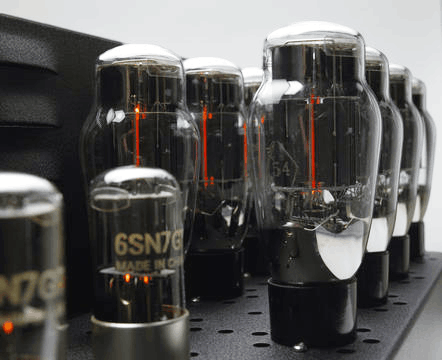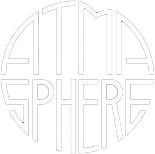So we chose the 6AS7G, which has had a traditional OTL history, as it was first used in OTLs as early as 1954. The 6AS7G is a dual-section power triode, meaning that two independent triodes are housed inside the glass envelope of the tube. The triode element itself is based on the 6B4 power triode, which was a single triode also in an octal base. The 6B4 itself is interesting, as it is the intermediate step between the 6AS7G and the original 2A3 power triode, which is a tube well-known to the single-ended triode community. The 6B4 was intended to be a 2A3 in a 'modern' tube base (octal), and employing the innovation/improvement of an indirectly heated cathode, making it more hum resistant. However the original directly heated cathode was what saw production.
A variant of the 6B4, the 12B4, was also produced. The 12B4 was a miniaturized form of the 6B4, in a 9-pin miniature package with a smaller (lower power) structure. It was intended primarily for voltage regulator and television service, but was featured as a power output tube in an OTL construction article in the fifties, penned by Julius Futterman. Of course, the 6B4 and the 2A3 don't look very similar; the tooling to make the 6B4 was redesigned. But on paper the two tubes have identical specs. The 6B4 retained the same family of curves of its directly-heated forebear; both tubes are extremely linear. This same linearity is a hallmark of all the tubes in this family including the 6AS7, which is one (but not the only) reason why the 6AS7G is a better sounding tube than the much-touted 300b. The sonic superiority of the 2A3 over the 300b is well-known in the single-ended world, it should come as no surprise that the 6AS7G follows the same path.
Of course, the 6AS7G was designed for more heavy duty service as a voltage regulator, although the first construction articles released by RCA (who developed the tube) in the late 1940s feature it as a power output tube. For voltage regulator service, the voltage characteristics of the tube were adjusted to favor lower voltage and higher current conditions, on condition that the original linearity would be retained. One of the changes that accomplished this was rearrangement of the grid structure; it was repositioned closer to the cathode element to retain the linearity at lower voltages. As in the 6B4, heatsinks were added and the otherwise simpler tooling was retained.
The result is a tube that is quite linear from roughly 50 to 250 volts, above which arc-over is a hazard. But in the power voltage range that it was designed for, the 6AS7 to this day retains several essential characteristics for OTL operation: Extremely high linearity (a legacy of its ancestry as well as original use requirements), relatively low filament requirements, extremely high transconductance and finally low cost.
These characteristics have caused us to retain the tube as our main platform despite constantly having re-evaluated the tube many times over the last 23 years. If treated properly, the tube is quite rugged. We have developed ways to extend the operation of the tube, by using it in a fixed-bias mode, which some readers may have noted is not recommended in the tube manuals. Of course it turns out that this is quite practicable, as we have demonstrated our amplifiers to be quite reliable over the last 2 decades. Actually, we found the concept of self-biasing as described in the tube manuals to be far more impractical!
During the 1980s, 1990s and now in the 21st century, the Russian form of the 6AS7, the 6H13 (and to a lesser extent the 6H7), has been the mainstay version of the 6AS7G. Having used this form of the tube quite a lot over the last 20 years, we have found it to be quite consistent and reliable, with the tube quality being unchanged in the 20 years we have been using it. The Russian tube industry has apparently had good reason to make the tube in very large quantities, in fact it appears to have been the most common power triode made by the Russians. One of the main benefits of this is low cost, without a sacrifice of quality.
More recently we have discovered that there is also a Chinese 6AS7G. It is built from the same tooling as its Russian counterpart, and seems to be similar quality. Thus the 6AS7G remains the tube of choice for our amplifiers.

